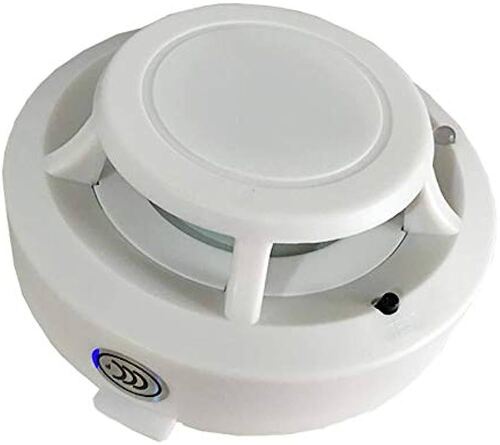Product Description
A wireless smoke detector is a device designed to detect smoke and trigger an alarm in the event of a fire. Unlike traditional wired smoke detectors, wireless smoke detectors communicate with a central control panel or other interconnected devices using wireless technology, such as Wi-Fi, Bluetooth, Zigbee, or proprietary radio frequencies. These detectors are commonly used in residential and commercial buildings to enhance fire safety and provide flexible installation options.
Here are some key features and benefits of wireless smoke detectors:
1. Easy Installation: Wireless smoke detectors are easier to install than their wired counterparts because they don't require extensive wiring. This makes them suitable for both new construction and retrofitting in existing buildings.
2. Interconnectivity: Many wireless smoke detectors can be interconnected with other smoke detectors and fire alarm devices, such as heat detectors, carbon monoxide detectors, and fire alarm control panels. When one detector detects smoke, it can trigger all interconnected devices to sound an alarm simultaneously.
3. Remote Monitoring: Some wireless smoke detectors can be connected to a central monitoring system, which can alert emergency services or notify homeowners remotely when smoke is detected, even when they are away from the property.
4. Battery Backup: Wireless smoke detectors typically have battery backup systems to ensure they continue functioning during power outages. This is essential for maintaining fire protection when electrical power is unavailable.
5. Tamper Alerts: Some models include tamper-resistant features, which can trigger an alert if someone tries to disable or tamper with the detector.
6. Integration with Smart Home Systems: Many wireless smoke detectors can integrate with smart home systems, allowing homeowners to receive alerts on their smartphones, tablets, or other connected devices. Integration with voice assistants like Amazon Alexa or Google Assistant is also possible, enabling voice alerts and control.
7. Reduced False Alarms: Advanced wireless smoke detectors often incorporate sophisticated sensors and algorithms to reduce false alarms caused by cooking smoke or steam, helping prevent unnecessary disruptions.
8. Regular Maintenance Alerts: Some wireless detectors have self-diagnostic features that can alert homeowners or maintenance personnel when the device needs cleaning or replacement.
FAQ:
Q. What is a wireless smoke detector?
Ans: A wireless smoke detector is a device designed to detect the presence of smoke, which may indicate a fire, and wirelessly communicate this information to other devices or a central control panel. It is used for fire detection and alarm purposes.
Q. How do wireless smoke detectors work?
Ans: Wireless smoke detectors use sensors, typically ionization or photoelectric sensors, to detect smoke particles in the air. When smoke is detected, the detector triggers an alarm and wirelessly sends a signal to interconnected devices or a central control panel, which can then activate alarms, notifications, or other safety measures.
Q. Are wireless smoke detectors as reliable as wired ones?
Ans: When installed and maintained correctly, wireless smoke detectors are just as reliable as wired detectors. They offer the advantage of easier installation and flexibility in placement but require periodic battery replacement and regular testing to ensure their reliability.
Q. Do wireless smoke detectors require batteries?
Ans: Yes, most wireless smoke detectors require batteries for power, even if they are connected to a building's electrical system. The batteries serve as a backup power source in case of power outages. It's essential to replace these batteries as needed to ensure the detector's continuous operation.
Q. How often should I replace the batteries in a wireless smoke detector?
Ans: Manufacturers typically recommend replacing the batteries in wireless smoke detectors at least once a year or as soon as you hear a low-battery warning signal. Regular battery replacement is crucial to ensure the detector's functionality during emergencies.
Q. Can wireless smoke detectors be interconnected with other devices?
Ans: Yes, many wireless smoke detectors can be interconnected with other smoke detectors, carbon monoxide detectors, heat detectors, and fire alarm control panels. This interconnectivity allows all interconnected devices to trigger alarms simultaneously when smoke or a fire is detected in one location.
Q. Can wireless smoke detectors be integrated with smart home systems?
Ans: Yes, several wireless smoke detector models are compatible with smart home systems and can be integrated with platforms like Amazon Alexa, Google Assistant, or home automation systems. This integration allows for remote monitoring and control using smartphones or voice commands.
Q. Do wireless smoke detectors have false alarm reduction features?
Ans: Some advanced wireless smoke detectors incorporate technology to reduce false alarms caused by cooking smoke or steam. These features use advanced sensors and algorithms to distinguish between actual fire threats and common household nuisances.
Q. How do I test a wireless smoke detector?
Ans: Most wireless smoke detectors have a test button that allows you to initiate a self-test. When pressed, the detector should sound an alarm, indicating that it's functioning correctly. Test your smoke detectors regularly, at least once a month, to ensure they are operational.
Q. Can I install wireless smoke detectors myself, or do I need a professional installer?
Ans: Many wireless smoke detectors are designed for easy DIY installation, making them accessible to homeowners. However, if you're not comfortable with installation or want to ensure compliance with local building codes, it's advisable to consult a professional installer or electrician.
